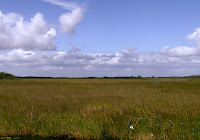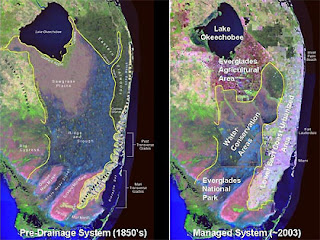The Everglades is composed of five different habitats, each
one with different plants and animals living together. These habitats include
hardwood hammock, which includes groups of broad-leafed trees then grow in a
similar formation to a hammock. Some of
the plants that grow in this area include mahogany, gumbo limbo, and the
cocoplum. Animals include the grey fox, various snakes and, toads.
Another
habitat in the Everglades is the mangroves. Mangroves thrive where salt water
and fresh water mix. Currently the Everglades National Park contains the
largest strand of a protected mangrove forest in the hemisphere. Species that
live in the area include the red black and white mangroves, along with the
American crocodile, various types of birds, and manatee.
The next
habitat is pineland. Pineland take root in exposed limestone, and the terrain
is composed of slash pine. Various flowers grow in the surrounding area. Fire
is essential for the continuous growth of pineland, and the plants are adapted
to a life of frequent fires. This area is home to many of the snakes of the
Everglades.
Saw grass
parries are another familiar habitat to the area. This habitat remains wet for
most of the year. As the name states, saw grass is the most dominate plant
species of this habitat. Other species include the bladderwort, and the
periphyton. This habitat is home to some of the most vast array of birds in the
Everglades.
The last
habitat of the surrounding area is the freshwater slough. The freshwater slough
is a marshy river that channels water through the Everglades. There are two
main sloughs of the Everglades, they include the shark river slough, and the
taylor slough, which both empty into the Florida Bay. Throughout the sloughs
you might see tree islands sprouting sparingly. Animals that dwell in these
areas include, alligator, snapping turtles, fish, and otters.
http://upload.wikimedia.org/wikipedia/commons/5/50/Cypress_Hammock_Everglades.jpg
Hardwood Hammock
http://www.shannontech.com/ParkVision/Everglades/Evg-119.jpg
Mangroves
http://upload.wikimedia.org/wikipedia/en/4/45/Everglades_Pinelands.jpg
Pineland
http://upload.wikimedia.org/wikipedia/commons/3/36/Everglades_Sawgrass_Prairie_Moni3.JPG
Saw grass prarie
http://www2.fiu.edu/~jheffer/Images/DSCN3041.JPG
Freshwater slough










